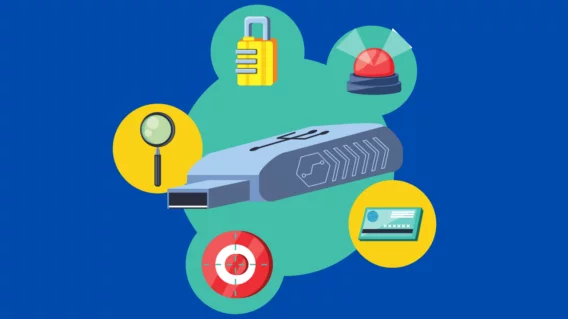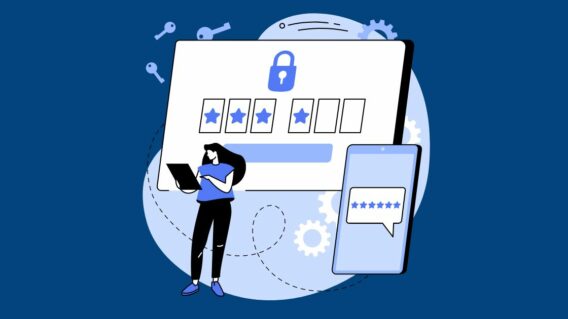Beware of the Middleman: Preventing MiTM Attacks

Within cybersecurity, certain threats have consistently managed to create chaos for businesses, regardless of their size or sector. Man-in-the-middle (MiTM) attacks are one such pervasive danger.
As a business owner, understanding MiTM attacks is not just about enhancing cybersecurity knowledge, it’s about safeguarding your business, your reputation, and your bottom line. In this comprehensive guide, we’ll explore the mechanisms, types, and prevention strategies for MiTM attacks.
What is an MITM Attack?
A MiTM attack can be likened to eavesdropping but in the cyber domain. During this type of cyber attack, an unauthorized entity deliberately positions itself between two parties communicating online. This unsolicited “middleman” intercepts, and potentially alters, or exfiltrates the data being exchanged, all the while remaining undetected by the involved parties.
The rationale behind these attacks varies. For some hackers, the motivation might be data theft, pilfering sensitive information like login credentials, personal details, or financial data. For others, it could be to introduce malicious software into a victim’s system, sabotage communication, or even to conduct espionage. Given the clandestine nature of MiTM attacks, they can carry on for extended periods without detection, leading to prolonged exposure and potential damage.
In essence, while the concept of “eavesdropping” might seem simple, in the context of cyber threats, a MiTM attack is a multifaceted and sophisticated challenge that poses significant risks to any online communication or transaction.
How Do Man in the Middle Attacks Work?
When navigating the complexities of online communication, it’s paramount to understand how malicious entities can exploit this environment to their advantage. We can discern two primary phases in the execution of a MiTM attack: interception and decryption.
Phase 1 – Interception
Interception is the act of covertly seizing the communication between two parties without their knowledge. This can be likened to tapping a telephone line without either party on the call being aware. To achieve this, cybercriminals may:
- Exploit weak or open Wi-Fi networks, particularly in public places. Such networks become gateways for attackers to access the data traffic flowing through them.
- Manipulate Domain Name System (DNS) servers, leading users to fake websites instead of their intended destinations.
- Utilize advanced techniques like IP spoofing or cache poisoning to manipulate the routing of data packets and redirect traffic to their controlled endpoints.
By successfully intercepting communication, attackers position themselves to capture valuable data transmitted between users, alter that data, or even redirect users to malicious sites.
Phase 2 – Decryption
Once the data is intercepted, the next challenge for the attacker is making sense of it. Often, data transmitted online, especially sensitive information, is encrypted for security. The decryption phase involves:
- Unraveling the captured encrypted data, turning the jumbled mess into intelligible information.
- Leveraging specialized tools or leveraging vulnerabilities in encryption protocols to decode data.
Decrypted data is a goldmine for attackers, offering insights into personal details, financial information, login credentials, and more. This information can then be weaponized for various malicious activities, from unauthorized transactions to identity theft.
Man-in-the-Middle Attack Examples
Man-in-the-middle attacks encompass a spectrum of techniques, each leveraging unique vectors and vulnerabilities to compromise data integrity. To provide a comprehensive understanding of the breadth and depth of MiTM threats, we’ve curated a list of some prominent types of these attacks, illustrating how they function and their potential ramifications.
Rogue Access Point
At the heart of a Rogue Access Point attack is the deceitful establishment of a Wi-Fi hotspot. Cybercriminals set up these hotspots, often in public places, mimicking legitimate network names (SSIDs). Unsuspecting users, thinking they are connecting to a familiar network, unwittingly expose their data to the attacker. Once connected, all their traffic flows through this malicious access point, rendering their data vulnerable to interception and manipulation.
ARP Spoofing (Address Resolution Protocol Spoofing)
ARP is crucial for mapping 32-bit IP addresses to MAC addresses within a local network, facilitating device-to-device communication. In ARP Spoofing, attackers send fake ARP messages onto the local network, deceiving devices into associating the attacker’s MAC address with the IP address of a legitimate device (often a gateway).
This misdirection allows the attacker to intercept, modify, or even halt data transmissions, positioning themselves between the user and the network gateway.
DNS Spoofing (Domain Name System Spoofing)
The Domain Name System (DNS) translates user-friendly domain names (like www.example.com) into IP addresses that computers use to identify each other. In DNS Spoofing, attackers corrupt the DNS table in a server, causing users who request the IP address of a specific domain to receive a falsified IP address, often leading them to malicious websites. This misdirection can result in theft of personal information or the injection of malware.
IP Spoofing
IP Spoofing involves cybercriminals disguising their actual IP address to appear as if they are a trusted source. This is primarily used to bypass IP-based security measures or to launch distributed denial-of-service (DDoS) attacks by flooding a target with traffic, all appearing to come from legitimate and diverse IP addresses.
SSL Stripping
Secure Sockets Layer (SSL) is a protocol that encrypts data transmitted over networks. In SSL Stripping, attackers downgrade a user’s connection from the secure HTTPS to the unsecured HTTP protocol. By doing this, they can eavesdrop on data, which would otherwise have been encrypted.
Session Hijacking
One of the subtler MiTM attacks, Session Hijacking entails an attacker intercepting and taking over a user’s session, typically after a user has logged in. Leveraging the user’s session token, the attacker can impersonate the user, gaining unauthorized access to protected resources or accounts.
A Glimpse into Real-World MiTM Attacks
One of the most alarming real-world examples of a MiTM attack centers around a malicious module named shaDll. This particular tool was designed to install counterfeit SSL certificates onto compromised devices. Once installed, attackers could exploit these counterfeit certificates to deceive users and intercept communications they believed to be secure.
By leveraging shaDll, cybercriminals were not merely eavesdropping. They actively redirected web activities, capturing critical data like login credentials, financial details, and personal information. This method allowed them to initiate fraudulent transactions, steal identities, or further spread malware.
What makes the shaDll incident stand out is its demonstration of the increasingly intricate methods employed in MiTM attacks. It also revealed potential collaborations between various cybercrime factions, with tools and techniques being shared or sold among different groups.
This escalating complexity is a stark reminder of how MiTM strategies are constantly advancing. Attacks like these reinforce the critical importance of not only being aware of potential threats but also investing in comprehensive, up-to-date security solutions to counteract them.
How to Prevent MITM Attacks
Defending against Man-in-the-Middle attacks requires a multi-faceted approach. These attacks exploit a range of vulnerabilities, from physical network infrastructure to user behavior. As such, mitigation strategies must be equally diverse. Here are some actionable steps and recommendations that businesses can deploy to shield themselves and their networks from the threats posed by MiTM attacks.
Secure Wi-Fi Networks
Encryption: Ensure that Wi-Fi networks are encrypted using robust protocols like WPA3. Older protocols like WEP and WPA have known vulnerabilities and can be easily compromised.
Use Strong Passwords: Always employ complex passwords and set up multi-factor authentication for your Wi-Fi network when possible.
Implement HTTPS and SSL/TLS
Force HTTPS: Always use websites that employ HTTPS, and consider using plugins like HTTPS Everywhere to ensure you’re on a secured version of a website.
Verify SSL/TLS Certificates: Before trusting a site, check its SSL/TLS certificate. Be wary of any certificate warnings your browser may present.
End-to-End Encryption: Ensure that data remains encrypted not just in transit but at rest and during processing.
Educate and Train Staff
Phishing Awareness: Regularly train staff to recognize and avoid phishing emails, which can be used to initiate MiTM attacks.
Safe Browsing Habits: Teach staff to avoid unknown Wi-Fi networks and always verify website certificates before inputting sensitive information.
Employ Network Monitoring and Intrusion Detection Systems
Continuous Monitoring: Emsisoft’s business security solution continuously monitors network traffic for suspicious patterns, offering real-time threat detection.
Use Intrusion Detection Systems (IDS): These systems analyze network traffic, flagging or blocking any malicious activities. Emsisoft’s multi-layered approach to security includes IDS as well as behavior-based monitoring and detection.
Stay Updated
Patch and Update Regularly: Always keep operating systems, software, and firmware updated. Cybercriminals often exploit known vulnerabilities in outdated systems.
Stay Informed: Regularly review new cyber threats and adjust your security practices accordingly.
Employ DNS Security
Use DNSSEC (DNS Security Extensions): This suite of extensions ensures DNS data integrity and authentication.
Secure DNS Servers: Ensure your DNS servers are protected against potential attacks, like DNS spoofing, by employing security solutions and practices tailored for them.
Emsisoft’s Role in Preventing MITM Attacks
Emsisoft plays an integral part in bolstering security against MiTM and other cyber threats. Emsisoft’s solutions, backed by cutting-edge technology and real-time monitoring capabilities, offer robust defense layers against various types of cyber attack. By shielding endpoints and proactively guarding against malware and suspicious network activity, Emsisoft ensures that business operations remain uncompromised and data transmissions secure.
By employing these strategies and tools, businesses can significantly reduce their vulnerability to Man-in-the-Middle attacks, safeguarding their data, reputation, and bottom line.
Man in the Middle Cyber Attacks: FAQs
Navigating the intricacies of MiTM attacks can be challenging. To provide clarity on some of the most pressing questions, we’ve compiled this FAQ section.
Can VPN stop MiTM?
Yes, a VPN (Virtual Private Network) can help mitigate the risks of MiTM attacks. VPNs encrypt your data traffic, making it challenging for attackers to intercept and decipher the data. However, it’s crucial to use reputable VPN providers as some may not provide adequate security or might even be malicious.
What’s the difference between MiTM and phishing?
While both involve deceit, MiTM attacks intercept and potentially alter communications between two parties without their knowledge. In contrast, phishing typically involves tricking someone into providing sensitive information directly, often through fake websites or deceptive emails.
How can I tell if I’m a victim of an MiTM attack?
Some signs include unexpected certificate warnings in your browser, a sudden drop in connection speeds, or being redirected to unfamiliar web addresses. Regularly monitoring network traffic and employing intrusion detection systems can also help identify such attacks.
Are mobile devices susceptible to MiTM attacks?
Absolutely. Mobile devices, just like computers, can be targeted. Unsecured Wi-Fi networks are especially dangerous for mobile users. Always be cautious when connecting to public Wi-Fi and consider using a VPN.
Does HTTPS prevent MiTM attacks?
HTTPS does offer protection against MiTM by encrypting the data between the website server and the browser. However, if an attacker possesses a valid SSL certificate, they might still execute a MiTM attack. Therefore, always verify website certificates.
What is SSL stripping in the context of MiTM?
SSL stripping is a technique where the attacker downgrades a victim’s connection from HTTPS to HTTP. By doing this, the attacker can intercept unencrypted traffic, making MiTM easier to execute.
How does ARP spoofing work in MiTM?
ARP spoofing involves the attacker sending fake ARP (Address Resolution Protocol) messages to a local network. This allows the attacker to link their MAC address with the IP address of a legitimate network device, redirecting traffic through the attacker’s machine.
Is using public Wi-Fi safe?
Public Wi-Fi networks, especially those without passwords, are more vulnerable to MiTM attacks. If you must use public Wi-Fi, avoid accessing sensitive sites or transmitting personal data and consider using a VPN.
Are MiTM attacks only concerned with data interception?
Not always. While data interception is a primary goal, MiTM attacks can also be used to inject malicious data into a communication stream, potentially leading to malware infections or other security breaches.
How does DNS spoofing relate to MiTM?
DNS spoofing, or DNS cache poisoning, involves altering DNS records to redirect users to fraudulent websites. This can be used as part of a MiTM attack to capture user information.
Can regularly updating software help prevent MiTM?
Yes, regular software updates often include patches for known vulnerabilities that could be exploited in MiTM attacks. Always keep your systems and applications updated.
What measures can I take to prevent MiTM attacks?
Taking precautions such as using VPNs, enabling HTTPS everywhere, frequently checking for and updating software, and avoiding public Wi-Fi or using it cautiously can reduce the risk of MiTM attacks. Employing multi-factor authentication (MFA) can also add an extra layer of security.
Do all MiTM attacks require the attacker to be on the same network?
No, while many MiTM attacks, like ARP spoofing, require the attacker to be on the same local network, there are other methods where an attacker might not need to be on the same network. They could exploit vulnerabilities from anywhere on the internet, depending on the attack vector.
How do companies detect and prevent MiTM attacks on a larger scale?
Many organizations employ Network Intrusion Detection Systems (NIDS), Network Intrusion Prevention Systems (NIPS), and robust firewalls. They also conduct regular security audits, penetration testing, and employee training to stay vigilant against potential threats.
Does end-to-end encryption make communications immune to MiTM?
End-to-end encryption ensures that only the sender and recipient can decipher the message. While this makes data interception less useful for an attacker, it doesn’t prevent the attack itself. If encryption keys are compromised, MiTM attacks can still be successful.
Emsisoft Enterprise Security + EDR
Robust and proven endpoint security solution for organizations of all sizes. Start free trialAre there legal consequences for executing MiTM attacks?
Yes, unauthorized interception, alteration, or access to digital communications, including MiTM attacks, is illegal in many jurisdictions. Perpetrators can face criminal charges, fines, and imprisonment depending on the extent of the attack and damage caused. Always consult local laws for specifics.


